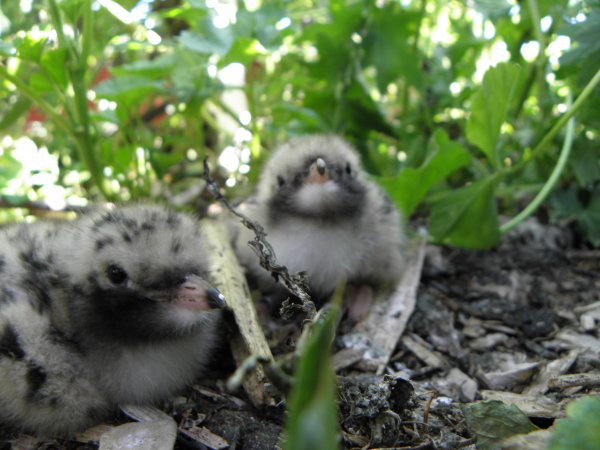If you are lucky enough to be visiting Presqu’ile between May and August, just take a moment to stop and listen along the shoreline and you will be rewarded by the shrill cry keeuri-keeuri-keeuri of Common Terns foraging just offshore. These beautiful waterbirds are about the size of a blue-jay but are rarely seen on land, spending most of their time over the water and, in the winter, off the coast of Peru.

“In the 1960s, over 10,000 nesting terns were recorded on Gull Island but since the 1970s this has dropped to only around 100 nests each year”, says Dr. Jennifer Arnold from Penn State University. Dr. Arnold, Dr. Oswald and their student interns have been studying Presqu’ile Common Terns intensively since 2008.
“Compared to extensive research in coastal areas, relatively little is known about Common Terns in inland regions”, says Dr. Arnold, “What we have found surprised us. Building on earlier work by researchers in this region, our studies suggest that these birds may be ecologically very different. This has turned much of our understanding of this species upside-down!”
Dr. Arnold’s research has documented notable differences for freshwater breeding terns in their development, colony dynamics, habitat preferences and ecology. These have, in turn, fed directly into management initiatives for common terns at the park. “We found fairly early on that each year most Common Tern chicks were being eaten at night by another important waterbird species, the Black-crowned Night Heron,” says Dr. Arnold. These herons are smaller than the more familiar Great Blue Heron but still much bigger than the Common Tern chicks. “Within a matter of a few days, a colony of 100 nests, many with growing chicks, can become a ‘ghost town’”.

In its eleventh year, Dr. Arnold’s research on Common Terns is helping to keep this beautiful bird at the park. Over a decade of research may seem like a long time, but these birds can live over 20 years and so it is only part of the story. “Unfortunately, there are always surprises.”, she laments, “In 2017, the extensive flooding destroyed the predator exclusion grids. Thus, we are trialing a more flexible grid style, one that we could get up and running for 2018.” The structure has helped the terns maintain their breeding foothold on Gull Island and once more over 100 pairs of Common Terns are breeding here. There is even a smaller colony on High Bluff Island this year, as several birds had nested there in 2017 because of the high water.
In addition, Dr. Arnold and her team have been conducting two other studies at Presqu’ile in 2018, supported in part by grants from the Friends. “We have a student-led project examining sleep behavior in Common Terns. No-one knows about sleep patterns in this species and using infra-red cameras we are learning a lot. It appears that birds are responding directly to the threat of a nocturnal predator by missing out on sleep to literally ‘keep one eye open’”. Another study has been using cutting-edge logging devices to examine foraging locations within inland populations. With Presqu’ile data to be collected in 2019, this research is designed to address why Common Terns are attracted to Presqu’ile despite the threat of predation and how smaller lakes contribute to the declining inland populations.
“We have made a lot of progress, but there’s still a lot to learn about Common Terns at Presqu’ile and throughout inland areas. Our studies provide a window on the life and fortunes of this beautiful bird but continued work is the key to securing their future at Presqu’ile for the enjoyment of the next generation of visitors.”


